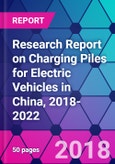The development of charging piles expands as the sales and reserves of electric vehicles grows rapidly in China. From 2013 to May 2018, the number of charging piles in China increased from more than 20,000 to more than 260,000. The number of charging piles in China is increasing rapidly but the growth rate is far behind that of electric vehicles, which means that there is a huge demand for charging piles in China. In 2017, the size of China's charging pile market exceeded CNY 20 billion.
It is estimated that the sales of electric vehicles will continue to increase in China from 2018 to 2022 with the government's policy support and the price reduction resulting from cost reduction. Critical to electric vehicles, the development of charging facilities will benefit fully from the fast growth of electric vehicles. The government's policy support provides the charging pile industry with a plenty of market opportunities. And the immaturity of the industry also gives promise of huge development potential. In addition, the charging pile industry is a new industry that requires constant exploration. According to the NDRC's Guidelines for Development of Electric Vehicle Charging Infrastructure (2015-2020), the development goal of China's charging infrastructure is to build 12,000 charging stations and 4.8 million charging piles by 2020 to meet the charging needs of 5 million electric vehicles nationwide. The total investment in charging piles will exceed CNY 184 billion if the number of new energy vehicles reaches 5 million, the production capacity of electric vehicles reaches 2 million, and the total production and sales volume exceeds 5 million in 2020. Therefore, there will be a large growth potential for China's charging pile market from 2018 to 2022.
Topics Covered:
- The policy environment and economic environment for the charging pile industry
- The development of China's charging pile industry
- Major charging pile manufacturers in China
- Market competition of charging piles
- Driving forces and market opportunities for China's charging pile industry, 2018-2022
- Prospects of China's charging pile industry, 2018-2022
Table of Contents
Companies Mentioned
- NARI Technology Development Co., Ltd.
- XJ Electric Co., Ltd.
- Nanjing Nengrui Electric Power Technology Co., Ltd.
- Shenzhen Auto Electric Power Plant Co., Ltd.
- Xiamen Kehua Hengsheng Co., Ltd.
- State Grid Electric Vehicle Service Co., Ltd.
- Qingdao TGood EVC Co., Ltd.
- Potevio New Energy Co., Ltd.
- Wanbang New Energy Investment Group Co., Ltd.
Methodology
Background research defines the range of products and industries, which proposes the key points of the research. Proper classification will help clients understand the industry and products in the report.
Secondhand material research is a necessary way to push the project into fast progress. The analyst always chooses the data source carefully. Most secondhand data they quote is sourced from an authority in a specific industry or public data source from governments, industrial associations, etc. For some new or niche fields, they also "double-check" data sources and logics before they show them to clients.
Primary research is the key to solve questions, which largely influence the research outputs. The analyst may use methods like mathematics, logical reasoning, scenario thinking, to confirm key data and make the data credible.
The data model is an important analysis method. Calculating through data models with different factors weights can guarantee the outputs objective.
The analyst optimizes the following methods and steps in executing research projects and also forms many special information gathering and processing methods.
1. Analyze the life cycle of the industry to understand the development phase and space.
2. Grasp the key indexes evaluating the market to position clients in the market and formulate development plans
3. Economic, political, social and cultural factors
4. Competitors like a mirror that reflects the overall market and also market differences.
5. Inside and outside the industry, upstream and downstream of the industry chain, show inner competitions
6. Proper estimation of the future is good guidance for strategic planning.

LOADING...








